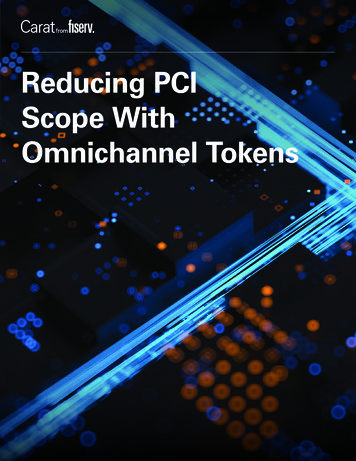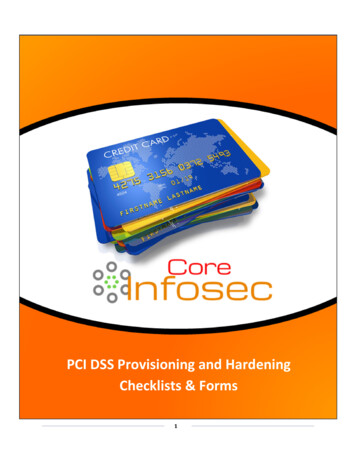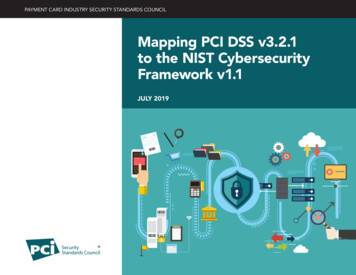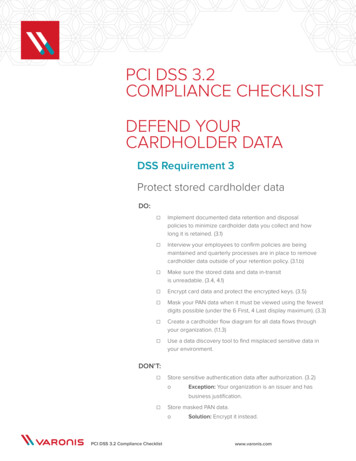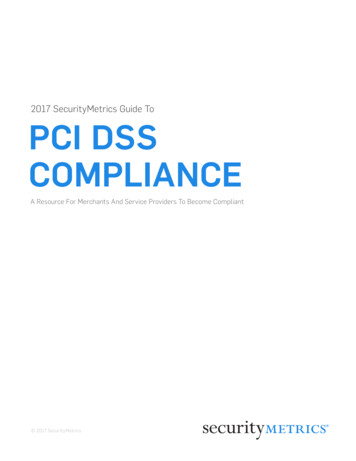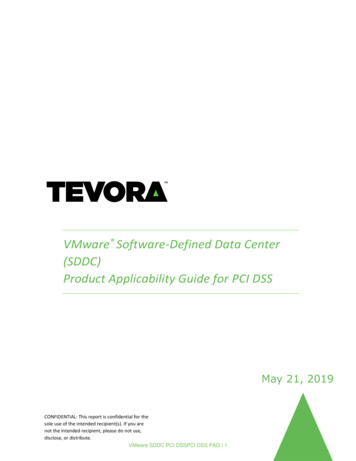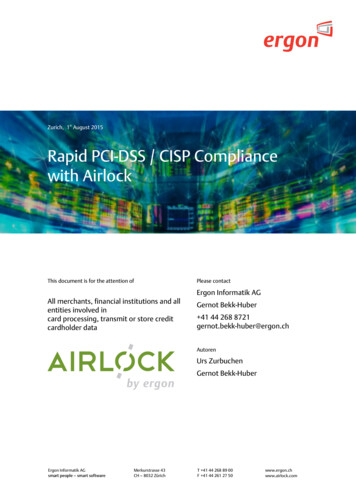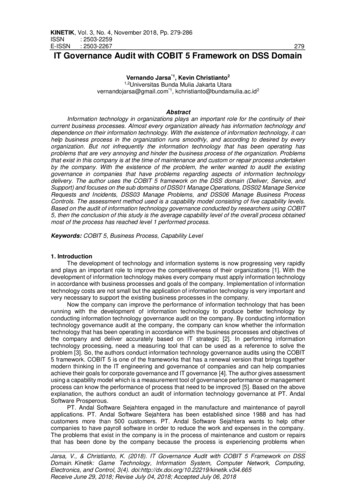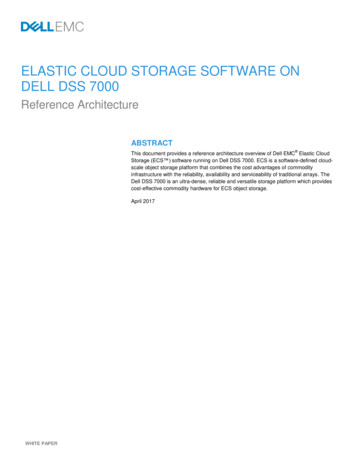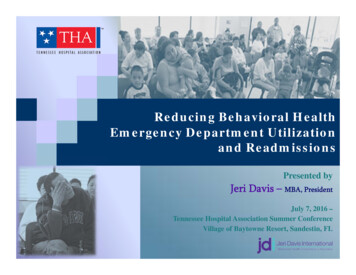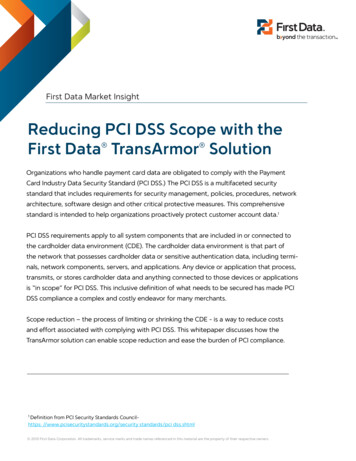
Transcription
First DataMarketInsightFirst DataMarketInsightReducing PCI DSS Scope with theTransArmorSolution SolutionFirst Data TransArmorSMOrganizations who handle payment card data are obligated to comply with the PaymentCard Industry Data Security Standard (PCI DSS.) The PCI DSS is a multifaceted securitystandard that includes requirements for security management, policies, procedures, networkarchitecture, software design and other critical protective measures. This comprehensivestandard is intended to help organizations proactively protect customer account data.1PCI DSS requirements apply to all system components that are included in or connected tothe cardholder data environment (CDE). The cardholder data environment is that part ofthe network that possesses cardholder data or sensitive authentication data, including terminals, network components, servers, and applications. Any device or application that process,transmits, or stores cardholder data and anything connected to those devices or applicationsis “in scope” for PCI DSS. This inclusive definition of what needs to be secured has made PCIDSS compliance a complex and costly endeavor for many merchants.Scope reduction – the process of limiting or shrinking the CDE - is a way to reduce costsand effort associated with complying with PCI DSS. This whitepaper discusses how theTransArmor solution can enable scope reduction and ease the burden of PCI compliance.1 Definitionfrom PCI Security Standards Councilhttps: //www.pcisecuritystandards.org/security standards/pci dss.shtml 2010 First Data Corporation. All trademarks, service marks and trade names referenced in this material are the property of their respective owners.
First Data Market Insight The FirstData TransArmorsolutiondeliversstrong datasecurity toasmerchantsas parta serviceas part ofTransArmorsolution deliversstrongdata securityto merchantsa service asof processingprocessingpaymentcard transactions.solution incorporatesencryptionand tokenizationtechnologiespayment cardtransactions.The solutionTheincorporatesencryption andtokenizationtechnologiesto protect toprotectcard data.sensitivesensitivepaymentpaymentcard data.Following is an overview of how the TransArmor secure transaction management service works in a card-presentenvironment:1.When a purchase is made, the payment card number is captured and encrypted at themerchant’s point of sale (POS) terminal. The TransArmor software on the merchant’s POSterminal handles the encryption, which is asymmetric, meaning different keys are used forencryption than for decryption.2. The encrypted card data is transmitted over secure networks to First Data.3. First Data decrypts the Primary Account Number (PAN) using a secure private key.4. First Data presents the merchant’s transaction to the payment card brands (i.e., Visa, MasterCard,MAC, etc.) for authorization. Simultaneously, First Data checks the PAN against a tablepreviously processed payment cards to see if a token number has already been assigned to thecard number. If so, the existing token number assigned to that card is reused. If the paymentFirst Data TransArmor Secure Transaction Management Service: How it WorksMerchant EnvironmentFirst DataData Center1234PKI encryptionMerchantFirst Data Switch6Financial tokenMerchant6Issuer5Token NumberAssigned4Transaction logsettlementdata audMerchant 2010 First Data Corporation. All rights reserved.firstdata.compage 2
First Data Market Insightcard hasn’t been previously presented to First Data, then a new token number is randomlyassigned to the PAN, and First Data logs which token corresponds to the new PAN for futuretransactions. First Data re-encrypts the PAN and stores it as ciphertext within a highly securedata vault.5. First Data returns the payment authorization and the token number for the card to themerchant’s POS, where the information is stored with related transaction and cardholder data(i.e., SKUs for items purchased, cardholder name).6.The merchant uses the token number in other business processes, such as sales auditing,marketing analytics, loss prevention auditing and customer loyalty programs. Subsequent paymenttransactions, such as adjustments, refunds, “card not present” payments and delayed settlement,can also use the token in place of the card number.Scope Reduction DriversOn January 22, 2010, the PCI Security Standards Council (PCI SSC) provided guidance on the question “Isencrypted cardholder data considered cardholder data that must be protected in accordance with PCI DSS?”(Article #10359). The PCI SSC stated, “encrypted data may be deemed out of scope if, and only if, it has beenvalidated that the entity that possesses encrypted cardholder data does not have the means to decrypt it.”Therefore, if a merchant encrypts cardholder data but does not possess the means to decrypt it, the cardholderdata is not considered in scope once it has been encrypted.Typically, merchants operating in-house encryption systems for payment card data don’t benefit from reducedPCI scope, because the appiications and systems that use the card data must decrypt it to make it readableand usable. To take their encrypted card data environments outside the scope of PCI review, merchants mustcontract key management to an outside party, which, in turn, must prove it’s able to protect cryptographic keysin accordance with industry best practices such as those specified by the NIST or in the PCI DSS.The specific implementation of the TransArmor solution has several elements which enable users to remove carddata from PCI scope. The use of public key encryption is one enabler. Track data is encrypted with the PublicEncryption Key at the terminal and only the corresponding Private Encryption Key can be used to decrypt thisdata. Since the Merchant does not possess the Private Encryption Key, the Merchant “does not have the means todecrypt it.” Per the PCI SSC guidance, this data, once encrypted, can be considered out of scope.Tokenization of PAN data is the main enabler for scope reduction. The use of tokens for post-authorizationoperations (returns, chargebacks, recurring payments, sales reports, analytics or marketing programs) reducesthe instances of storage of the PAN and takes applications and systems for these business processes whichpreviously required PAN data out of scope as well.Another benefit of the TransArmor solution is that the payment processor is the only entity that the Merchantshares cardholder data with. The central database storing PANs and the systems with access to that databaseall reside outside the merchant’s environment, meaning the service provider, not the merchant, bears the burdenof proving adequate security for those systems. Since no cardholder data is being returned to the Merchant, anyService Providers that use the tokens for other business purposes or stores data for the Merchant would not bein scope. 2010 First Data Corporation. All rights reserved.firstdata.compage 3
First Data Market InsightWith these concepts as a base, we will now look in detail at how use of the TransArmor solution may affectthe completion of PCI DSS compliance questionnaires.Affected PCI Requirements - SAQ-DSAQ stands for “Self-Assessment Questionnaire”; SAQs must be completed by Merchants that are notrequired to undergo an on-site data security assessment and may be required by the merchant’s acquireror payment brand. Version D of the SAQ applies to Merchant who store cardholder data in electronic form.The SAQ-D contains the same requirements that the PCI DSS Audit Procedures contain, so this analysis alsopertains to Merchants that are required to have an on-site PCI DSS assessment by a QSA.The common layout of an SAQ-D Merchant performing card-present transactions, and the one that we’llfocus on here, is a PED terminal that is physically connected to an Electronic Cash Register (POS) that islogically connected to a Controller somewhere in the store by switches, routers and/or firewalls. The creditcard is swiped at the PED terminal, which then sends the transaction data to the ECR, which then sendsthe transaction data to the Controller, which then sends the transaction data to First Data. This is illustratedbelow.Authorization RequestCard Data(Encrypted)CardDataPOS and PEDCard Data(Encrypted)StoreControllerTokenCard DataSwitchTokenToken Server &Card VaultAuthorization ResponseDatabasesAndBack-End SystemsFollowing is an examination of the PCI SAQ D questions that are affected by the adoption of the TransArmorsolution:1.3.7Is the database placed in an internal network zone, segregated from the DMZ?This requirement refers to a database that is being used to store the PAN. Since TransArmor returns a tokenin place of the PAN, the database would only be storing the token number. Due to this, this requirementwould be considered not applicable to the Merchant.3.1(a) Is storage of cardholder data kept to a minimum, and is storage amount and retention timelimited to that which is required for business, legal, and/or regulatory purposes?(b) Is there a data-retention and disposal policy, and does it include limitations as stated in (a) above? 2010 First Data Corporation. All rights reserved.firstdata.compage 4
First Data Market InsightThe TransArmor solution first encrypts the PAN with a Public Encryption Key, which renders the PAN out ofscope outside of the PED terminal where the encryption is taking place, if for some reason it is being storedwithin the Merchant’s network. Any storage of this encrypted PAN would thus be out of scope for these tworequirements. Second, the TransArmor solution returns a token number in place of the PAN so any storageof the token would also be out of scope as the token is not considered to be cardholder data. Due to bothof these TransArmor solution processes, these two requirements would be considered not applicable to theMerchant.3.3Is the PAN masked when displayed (the first six and last four digits are the maximum number ofdigits to be displayed)?The TransArmor solution returns the token with only the last four digits of the PAN still intact. Therefore anydisplays (on the PED terminal, ECR, receipt, reports, etc.) will only be able to show the true last four digits ofthe PAN. This requirement would be considered in place (marked Yes) for the Merchant.3.4 Is PAN, at a minimum, rendered unreadable anywhere it is stored (including data on portable digitalmedia, backup media, and in logs) by using any of the following approaches?g One-way hashes based on strong cryptography.g Truncationg Index tokens and pads (pads must be securely stored)g Strong cryptography with associate key management processes and procedures.The TransArmor solution returns a token number in place of the PAN. If the token were being stored, it wouldcomply with this requirement according to the third bullet point. This requirement would therefore beconsidered in place (marked Yes) for this Merchant.3.4.1If disk encryption (rather than file- or column-level database encryption is used:(a) Is logical access managed independently of native operating system access control mechanisms(for example, by not using local user account databases)?(b) Are decryption keys independent of user accounts?Since the TransArmor solution encrypts at the transaction stage and only the tokenized PAN is return,there would not be a need for disk encryption. Therefore these two requirements would be considered notapplicable to the Merchant.3.5Are cryptographic keys used for encryption of cardholder data protected against both disclosureand misuse?The TransArmor solution uses a Public Encryption Key to encrypt the cardholder data. Unlike symmetricencryption keys, Public Encryption Keys are made to be distributed widely and cannot be used to decryptthe data that it used to encrypt. For this reason, the Public Encryption Key does not need to be protectedfrom disclosure or misuse as it is only half useful without the corresponding Private Encryption Key, which ishoused at First Data and not at the Merchant. However, the Public Encryption Key is protected within thePED terminal. This requirement would be considered not applicable to the Merchant. 2010 First Data Corporation. All rights reserved.firstdata.compage 5
First Data Market Insight3.5.1Is access to cryptographic keys restricted to the fewest number of custodians necessary?As stated for requirement 3.5 above, the TransArmor solution uses a Public Encryption Key, which is madeto be distributed widely and thus it does not need to be restricted to a few number of custodians. Further,each public key is signed with an X.509 certificate and terminals check the validity of the keys with acertificate authority in the First Data data center.As for the Private Encryption Key, it is housed at First Data, it is owned by First Data and it is also protectedand managed by First Data. Due to this, the Merchant is not responsible for the Private Encryption Key andcannot be assessed on it. This requirement would be considered not applicable to the Merchant.3.5.2Are cryptographic keys stored securely, and in the fewest possible locations and forms?The Public Encryption Key that the TransArmor solution uses is injected into the Merchant’s PED terminalsand is stored securely within. It is only stored in one form and the number of locations depends on thenumber of PED terminals that the Merchant has. As described above, the keys are also signed and protectedusing X.509 certificates. This requirement would be considered in place (marked Yes) for the Merchant.3.6(a) Are all key-management processes and procedures for cryptographic keys used for encryption ofcardholder data fully documented and implemented?(b) Do they include the following?3.6.1 Generation of strong cryptographic keys3.6.2 Secure cryptographic key distribution3.6.3 Secure cryptographic key storage3.6.4 Periodic changing of cryptographic keys:g As deemed necessary and recommended by the associated application (for example, re-keying),preferably automaticallyg At least annually3.6.5 Retirement or replacement of old or suspected compromised cryptographic keys3.6.6 Split knowledge and establishment of dual control of cryptographic keys3.6.7 Prevention of unauthorized substitution of cryptographic keys3.6.8 Requirement for cryptographic-key custodians to sign a form stating that they understand andaccept their key-custodian responsibilities.The TransArmor Public and Private Encryption Keys are owned and managed by First Data, not theMerchant. Therefore the Merchant would not need to have procedures for the management of theencryption keys. These nine requirements would be considered not applicable to the Merchant.4.1Are strong cryptography and security protocols, such as SSL/TLS or IPSEC, used to safeguardsensitive cardholder data during transmission over open, public networks?Since the TransArmor solution encrypts the cardholder data at the PED terminal, it remains encryptedthrough transmission until it reaches First Data. Therefore, this requirement would be considered notapplicable to the Merchant as the data is already encrypted prior to being transmitted over a publicnetwork. Alternative transport methods may be supported in the future, but they will all be standards suchas SSL/TLS. 2010 First Data Corporation. All rights reserved.firstdata.compage 6
First Data Market Insight4.2Are policies, procedures, and practices in place to preclude the sending of unencrypted PANs byend-user messaging technologies (for example, e-mail, instant messaging, chat)?Since the TransArmor solution first encrypts at the PED terminal the PAN being sent to First Data and thenonly returns a tokenized PAN, unencrypted PAN would not be available outside of the PED terminal. In otherwords, there wouldn’t be any unencrypted PAN available for employees to send via end-user messagingtechnologies. This requirement would be considered not applicable to the Merchant.8.6.16 Is all access to any database containing cardholder data authenticated? (This includes access byapplications, administrators, and all other users.)As with requirement 1.3.7 above, this requirement refers to a database that is being used to store the PAN.Since the TransArmor solution returns a token number in place of the PAN, the database would only bestoring the token. This requirement would be considered not applicable to the Merchant.9.1.1 (a) Do video cameras or other access-control mechanisms monitor individual physical access tosensitive areas?(b) Is data collected from video cameras reviewed and correlated with other entries?(c) Is data from video cameras stored for at least three months, unless otherwise restricted by law?Sensitive areas refer to “any data center, server room, or any area that houses systems that store cardholderdata. This excludes the areas where only point-of-sale terminals are present such as the cashier areas inretail stores.” Since the TransArmor solution returns a token number in place of the PAN, there would be nostorage of cardholder data thus no data centers, server rooms or any other area would house systems thatstore cardholder data. These three requirements would be considered not applicable to the Merchant.9.39.3.19.3.2Are all visitors handled as follows:Authorized before entering areas where cardholder data is processed or maintained?Given a physical token (for example, a badge or access device) that expires and that identifies thevisitors as non-employees?9.3.3 Asked to surrender the physical token before leaving the facility or at the date of expiration?9.4(a) Is a visitor log in use to maintain a physical audit trail of visitor activity?(b) Are the visitor’s name, the firm represented, and the employee authorizing physical accessdocumented on the log?(c) Is visitor log retained for a minimum of three months, unless otherwise restricted by law?With the TransArmor solution, the cardholder data is processed only at the PED terminal that is located inthe cashier area. Visitors there would consist of customers whom are always authorized to shop. Customerswould not be required to have a physical access token and would not be required to sign a visitor log.These six requirements would be considered not applicable to the Merchant. However, a best practice isto educate employees to not let anyone take or administrate a PED terminal or Electronic Cash Registerwithout proper authorization.9.5(a) Are media back-ups stored in a secure location, preferably in an off-site facility, such as analternate or backup site, or a commercial storage facility?(b) Is this location’s security reviewed at least annually? 2010 First Data Corporation. All rights reserved.firstdata.compage 7
First Data Market Insight9.6Are all paper and electronic media that contain cardholder data physically secure?9.7(a) Is strict control maintained over the internal or external distribution of any kind of media thatcontains cardholder data?(d) Do controls include the following:9.7.1 Is the media classified so it can be identified as confidential?9.7.2 Is the media sent by secured courier or other delivery method that can be accurately tracked?9.8Are processes and procedures in place to ensure management approval is obtained prior to movingany and all media containing cardholder data from a secured area (especially when media isdistributed to individuals)?9.9Is strict control maintained over the storage and accessibility of media that contains cardholderdata?9.9.1 (a) Are inventory logs of all media properly maintained?(b) Are media inventories conducted at least annually?9.10 Is media containing cardholder data destroyed when it is no longer needed for business or legalreasons?9.10.1 Are hardcopy materials shredded, incinerated, or pulped so that cardholder data cannot bereconstructed?9.10.2 Is electronic media with cardholder data rendered unrecoverable so that cardholder data cannot bereconstru
Reducing PCI DSS Scope with the TransArmor SM Solution Organizations who handle payment card data are obligated to comply with the Payment Card Industry Data Security Standard (PCI DSS.) The PCI DSS is a multifaceted security . This inclusive definition of what needs to be secured has made PCI DSS
